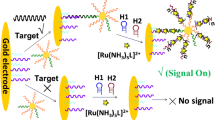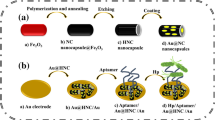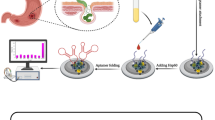Abstract
A novel electrochemical DNA sensor was designed to detect Helicobacter pylori based on accordion-like Ti3C2Tx. Here the multilayer Ti3C2Tx obtained by DMSO delamination was used to modify the glass carbon electrode, with a large specific surface area and excellent conductivity. Au nanoparticles were supported on the modified electrode and worked as an effective carrier to fix the capture probe (cpDNA) with sulfhydryl group through the firm binding of Au-S bond. Such an accordion-like Ti3C2Tx structure provides an ultrahigh electroactive surface area and ample binding sites for accommodating Au nanoparticles, which is advantageous for the signal amplification during the detection. And further, the sandwich structure formed by hybridizing cpDNA with target DNA sequence (tDNA) and rpDNA (rpDNA is a strand of DNA that can be base-paired with the tested tDNA) increases greatly the current signal and enhances the sensitivity of the electrochemical DNA sensor. Under optimal conditions, the developed electrochemical DNA sensor showed a wide linear range from 10−11 to 10−14 M and a low detection limit of 1.6 × 10−16 M and exhibited good sensitivity, reproducibility, and stability.
Graphical abstract

A novel electrochemical DNA sensor with simple sandwich structure was designed to detect H. pylori based on accordion-like Ti3C2Tx.






Similar content being viewed by others
References
Salama NR, Hartung ML, Müller A. Life in the human stomach: persistence strategies of the bacterial pathogen Helicobacter pylori. Nat Rev Microbiol. 2013;11:385.
Bauer B, Meyer FT. The human gastric pathogen Helicobacter pylori and its association with gastric cancer and ulcer disease. Ulcers. 2011;2011:1–23.
Jiménez-Soto LF, Rohrer S, Jain U, Ertl C, Sewald X, Haas R. Effects of cholesterol on Helicobacter pylori growth and virulence properties in vitro. Helicobacter. 2012;17(2):133–9.
Kern B, Jain U, Utsch C, Otto A, Busch B, Jiménez-Soto L, et al. Characterization of Helicobacter pylori VacA-containing vacuoles (VCVs), VacA intracellular trafficking and interference with calcium signalling in T lymphocytes. Cell Microbiol. 2015;17(12):1811–32.
Marshall B, Warren JR. Unidentified curved bacilli in the stomach of patients with gastritis and peptic ulceration. Lancet. 1984;323(8390):1311–5.
Gupta S, Tiwari A, Jain U, Chauhan N. Synergistic effect of 2D material coated Pt nanoparticles with PEDOT polymer on electrode surface interface for a sensitive label free Helicobacter pylori CagA(Ag-Ab) immunosensing. Mater Sci Eng C. 2019;103:109733.
Lin FYH, Sabri M, Erickson D, Alirezaie J, Li D, Sherman PM. Development of a novel microfluidic immunoassay for the detection of Helicobacter pylori infection. Analyst. 2004;129(9):823–8.
Sun C, Zhang L, Jiang J, Shen G, Yu R. Electrochemical DNA biosensor based on proximity-dependent DNA ligation assays with DNAzyme amplification of hairpin substrate signal. Biosens Bioelectron. 2010;25(11):2483–9.
Nosrati R, Golichenari B, Nezami A, Taghdisi SM, Karimi B, Ramezani M, et al. Helicobacter pylori point-of-care diagnosis: nano-scale biosensors and microfluidic systems. TrAC Trends Anal Chem. 2017;97:428–44.
Cui H-F, Xu T-B, Sun Y-L, Zhou A-W, Cui Y-H, Liu W, et al. Hairpin DNA as a biobarcode modified on gold nanoparticles for electrochemical DNA detection. Anal Chem. 2015;87(2):1358–65.
Marín AG, García-Mendiola T, Bernabeu CN, Hernández MJ, Piqueras J, Pau JL, et al. Gallium plasmonic nanoparticles for label-free DNA and single nucleotide polymorphism sensing. Nanoscale. 2016;8(18):9842–51.
Zhang L, Cao D, Tang T, Zuo Z, Huang J, Duan L. A label-free fluorescence method for detection of ureC gene and diagnosis of Helicobacter pylori infection. Luminescence. 2018;33(5):941–6.
Ali MM, Wolfe M, Tram K, Gu J, Filipe CDM, Li Y, et al. A DNAzyme-based colorimetric paper sensor for Helicobacter pylori. Angew Chem Int Edit. 2019;58(29):9907–9911.
Roussel Y, Wilks M, Harris A, Mein C, Tabaqchali S. Evaluation of DNA extraction methods from mouse stomachs for the quantification of H. pylori by real-time PCR. J Microbiol Methods. 2005;62(1):71–81.
Mikula M, Dzwonek A, Jagusztyn-Krynicka K, Ostrowski J. Quantitative detection for low levels of Helicobacter pylori infection in experimentally infected mice by real-time PCR. J Microbiol Methods. 2003;55(2):351–9.
Linke S, Lenz J, Gemein S, Exner M, Gebel J. Detection of Helicobacter pylori in biofilms by real-time PCR. Int J Hyg Environ Health. 2010;213(3):176–82.
Hvastkovs EG, Buttry DA. Recent advances in electrochemical DNA hybridization sensors. Analyst. 2010;135(8):1817–29.
Halim J, Kota S, Lukatskaya MR, Naguib M, Zhao M-Q, Moon EJ, et al. Synthesis and characterization of 2D molybdenum carbide (MXene). Adv Funct Mater. 2016;26(18):3118–27.
Tao Q, Dahlqvist M, Lu J, Kota S, Meshkian R, Halim J, et al. Two-dimensional Mo1.33C MXene with divacancy ordering prepared from parent 3D laminate with in-plane chemical ordering. Nat Commun. 2017;8:14949.
Ding R, Qi L, Wang H. An investigation of spinel NiCo2O4 as anode for Na-ion capacitors. Electrochim Acta. 2013;114:726–35.
Li L, Wang F, Zhu J, Wu W. The facile synthesis of layered Ti2C MXene/carbon nanotube composite paper with enhanced electrochemical properties. Dalton Trans. 2017;46(43):14880–7.
Xie X, Zhao M-Q, Anasori B, Maleski K, Ren CE, Li J, et al. Porous heterostructured MXene/carbon nanotube composite paper with high volumetric capacity for sodium-based energy storage devices. Nano Energy. 2016;26:513–23.
Liu H, Duan C, Yang C, Shen W, Wang F, Zhu Z. A novel nitrite biosensor based on the direct electrochemistry of hemoglobin immobilized on MXene-Ti3C2. Sensors Actuators B Chem. 2015;218:60–6.
Zhao T, Zhai P, Yang Z, Wang J, Qu L, Du F, et al. Self-supporting Ti3C2Tx foam/S cathodes with high sulfur loading for high-energy-density lithium–sulfur batteries. Nanoscale. 2018;10(48):22954–62.
Hu M, Cheng R, Li Z, Hu T, Zhang H, Shi C, et al. Interlayer engineering of Ti3C2Tx MXenes towards high capacitance supercapacitors. Nanoscale. 2020;12(2):763–71.
Xiao Z, Li Z, Li P, Meng X, Wang R. Ultrafine Ti3C2 MXene nanodots-interspersed nanosheet for high-energy-density lithium–sulfur batteries. ACS Nano. 2019;13(3):3608–17.
Huo X, Wang X, Li Z, Liu J, Li J. Two-dimensional composite of D-Ti3C2Tx@S@TiO2 (MXene) as the cathode material for aluminum-ion batteries. Nanoscale. 2020;12:3387–3399.
Han M, Yin X, Li X, Anasori B, Zhang L, Cheng L, et al. Laminated and two-dimensional carbon-supported microwave absorbers derived from MXenes. ACS Appl Mater Interfaces. 2017;9(23):20038–45.
Naguib M, Mochalin VN, Barsoum MW, Gogotsi Y. 25th anniversary article: MXenes: a new family of two-dimensional materials. Adv Mater. 2014;26(7):992–1005.
Yu X-f, Y-c L, Cheng J-b, Z-b L, Q-z L, W-z L, et al. Monolayer Ti2CO2: a promising candidate for NH3 sensor or capturer with high sensitivity and selectivity. ACS Appl Mater Interfaces. 2015;7(24):13707–13.
Sinha A, Dhanjai, Zhao H, Huang Y, Lu X, Chen J, et al. MXene: an emerging material for sensing and biosensing. TrAC. Trends Anal Chem. 2018;105:424–35.
Zou H, Zhang F, Wang H, Xia J, Gao L, Wang Z. Au nanoparticles supported on functionalized two-dimensional titanium carbide for the sensitive detection of nitrite. New J Chem. 2019;43(6):2464–70.
Wang H, Li H, Huang Y, Xiong M, Wang F, Li C. A label-free electrochemical biosensor for highly sensitive detection of gliotoxin based on DNA nanostructure/MXene nanocomplexes. Biosens Bioelectron. 2019;142:111531.
Fang Y, Yang X, Chen T, Xu G, Liu M, Liu J, et al. Two-dimensional titanium carbide (MXene)-based solid-state electrochemiluminescent sensor for label-free single-nucleotide mismatch discrimination in human urine. Sensor Actuators B Chem. 2018;263:400–7.
Alhabeb M, Maleski K, Anasori B, Lelyukh P, Clark L, Sin S, et al. Guidelines for synthesis and processing of two-dimensional titanium carbide (Ti3C2Tx MXene). Chem Mater. 2017;29(18):7633–44.
Rasheed PA, Pandey RP, Rasool K, Mahmoud KA. Ultra-sensitive electrocatalytic detection of bromate in drinking water based on Nafion/Ti3C2Tx (MXene) modified glassy carbon electrode. Sensor Actuators B Chem. 2018;265:652–9.
Huang H, Cui J, Liu G, Bi R, Zhang L. Carbon-coated MoSe2/MXene hybrid nanosheets for superior potassium storage. ACS Nano. 2019;13(3):3448–56.
Huang R, Chen S, Yu J, Jiang X. Self-assembled Ti3C2 /MWCNTs nanocomposites modified glassy carbon electrode for electrochemical simultaneous detection of hydroquinone and catechol. Ecotoxicol Environ Saf. 2019;184:109619.
Guo Q, Wu T, Liu L, Hou H, Chen S, Wang L. Flexible and conductive titanium carbide–carbon nanofibers for the simultaneous determination of ascorbic acid, dopamine and uric acid. J Mater Chem B. 2018;6(28):4610–7.
Mashtalir O, Naguib M, Mochalin VN, Dall’Agnese Y, Heon M, Barsoum MW, et al. Intercalation and delamination of layered carbides and carbonitrides. Nat Commun. 2013;4(1):1716.
Mashtalir O, Lukatskaya MR, Zhao M-Q, Barsoum MW, Gogotsi Y. Amine-assisted delamination of Nb2C MXene for Li-ion energy storage devices. Adv Mater. 2015;27(23):3501–6.
Wu X, Wang Z, Yu M, Xiu L, Qiu J. Stabilizing the MXenes by carbon nanoplating for developing hierarchical nanohybrids with efficient lithium storage and hydrogen evolution capability. Adv Mater. 2017;29(24):1607017.
Dong Y, Wu Z-S, Zheng S, Wang X, Qin J, Wang S, et al. Ti3C2 MXene-derived sodium/potassium titanate nanoribbons for high-performance sodium/potassium ion batteries with enhanced capacities. ACS Nano. 2017;11(5):4792–800.
Wu Y, Nie P, Wang J, Dou H, Zhang X. Few-layer MXenes delaminated via high-energy mechanical milling for enhanced sodium-ion batteries performance. ACS Appl Mater Interfaces. 2017;9(45):39610–7.
Maleski K, Mochalin VN, Gogotsi Y. Dispersions of two-dimensional titanium carbide MXene in organic solvents. Chem Mater. 2017;29(4):1632–40.
Satheeshkumar E, Makaryan T, Melikyan A, Minassian H, Gogotsi Y, Yoshimura M. One-step solution processing of Ag, Au and Pd@MXene hybrids for SERS. Sci Rep. 2016;6:32049.
Naguib M, Kurtoglu M, Presser V, Lu J, Niu J, Heon M, et al. Two-dimensional nanocrystals produced by exfoliation of Ti3AlC2. Adv Mater. 2011;23(37):4248–53.
Luo J, Tao X, Zhang J, Xia Y, Huang H, Zhang L, et al. Sn4+ ion decorated highly conductive Ti3C2 MXene: promising lithium-ion anodes with enhanced volumetric capacity and cyclic performance. ACS Nano. 2016;10(2):2491–9.
Li H, Tay RY, Tsang SH, Zhen X, Teo EHT. Controllable synthesis of highly luminescent boron nitride quantum dots. Small. 2015;11(48):6491–9.
Xue Q, Zhang H, Zhu M, Pei Z, Li H, Wang Z, et al. Photoluminescent Ti3C2 MXene quantum dots for multicolor cellular imaging. Adv Mater. 2017;29(15):1604847.
Frens G. Controlled nucleation for the regulation of the particle size in monodisperse gold suspensions. Nat Phys Sci. 1973;241(105):20–2.
Rakhi RB, Nayak P, Xia C, Alshareef HN. Erratum: novel amperometric glucose biosensor based on MXene nanocomposite. Sci Rep. 2016;6(1):38465.
Demers LM, Mirkin CA, Mucic RC, Reynolds RA, Letsinger RL, Elghanian R, et al. A fluorescence-based method for determining the surface coverage and hybridization efficiency of Thiol-capped oligonucleotides bound to gold thin films and nanoparticles. Anal Chem. 2000;72(22):5535–41.
Liu X, Liao G, Zou L, Zheng Y, Yang X, Wang Q, et al. Construction of bio/nanointerfaces: stable gold nanoparticle bioconjugates in complex systems. ACS Appl Mater Interfaces. 2019;11(43):40817–25.
Kang X, Wang J, Wu H, Aksay IA, Liu J, Lin Y. Glucose oxidase–graphene–chitosan modified electrode for direct electrochemistry and glucose sensing. Biosens Bioelectron. 2009;25(4):901–5.
Cao Y, Zhu S, Yu J, Zhu X, Yin Y, Li G. Protein detection based on small molecule-linked DNA. Anal Chem. 2012;84(10):4314–20.
Sguassero A, Artiga Á, Morasso C, Jimenez RR, Rapún RM, Mancuso R, et al. A simple and universal enzyme-free approach for the detection of multiple microRNAs using a single nanostructured enhancer of surface plasmon resonance imaging. Anal Bioanal Chem. 2019;411(9):1873–85.
Liu Z, Su X. A novel fluorescent DNA sensor for ultrasensitive detection of Helicobacter pylori. Biosens Bioelectron. 2017;87:66–72.
Tang H, Chen W, Li D, Duan X, Ding S, Zhao M, et al. Luminol-based ternary electrochemiluminescence nanospheres as signal tags and target-triggered strand displacement reaction as signal amplification for highly sensitive detection of Helicobacter pylori DNA. Sensors Actuators B Chem. 2019;293:304–11.
Funding
This work is supported by the National Natural Science Foundation of China (Grant Nos. 51672106 and 21802052) and Shandong Provincial Natural Science Foundation (Grant No. ZR2019MB066).
Author information
Authors and Affiliations
Corresponding authors
Ethics declarations
Conflict of interest
The authors declare no competing interests.
Additional information
Publisher’s note
Springer Nature remains neutral with regard to jurisdictional claims in published maps and institutional affiliations.
Supplementary information
ESM 1
(DOCX 1.04 mb)
Rights and permissions
About this article
Cite this article
Wang, L., Cui, K., Wang, P. et al. A sensitive electrochemical DNA sensor for detecting Helicobacter pylori based on accordion-like Ti3C2Tx: a simple strategy. Anal Bioanal Chem 413, 4353–4362 (2021). https://doi.org/10.1007/s00216-021-03391-8
Received:
Revised:
Accepted:
Published:
Issue Date:
DOI: https://doi.org/10.1007/s00216-021-03391-8




